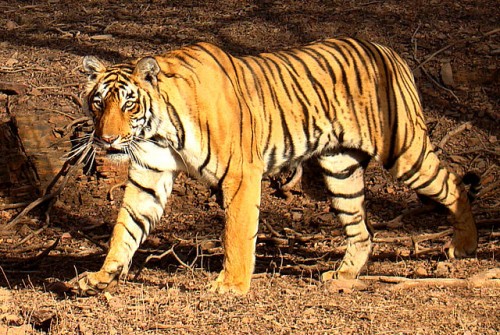by John M. Sellar, OBE FRGS

Do we still care about the fate of tigers?
In 1999, teams of law enforcement and conservation officials visited 14 countries that were either home to an ever-decreasing number of tigers left in the wild or were places where body parts of tigers were being consumed (predominantly illegally). The report of their work, findings and recommendations[i] is, very depressingly, all too relevant still today. Interestingly, the report was one of the first occasions where it was indicated that organized crime groups and networks had become involved in wildlife trafficking.
The number of tigers in the wild was estimated in the late 1990s to be somewhere between five and seven thousand. Surveys suggest that the number now may be slightly over three thousand. And this is despite umpteen projects, seminars, conferences and international initiatives. Such actions date back to the establishment of Project Tiger in 1973, when the then Prime Minister of India, Indira Ghandi, reacted to the realization that this species was headed towards extinction. The amount of money that has been spent in the intervening period must total many hundreds of thousands of dollars.
If numbers of tigers are used as a measurement of success, our efforts have failed. And failed miserably.
Conservationists will tell you that tigers can still be found in the following countries: Bangladesh, Bhutan, Cambodia, China, India, Indonesia, the Lao People’s Democratic Republic, Malaysia, Myanmar, Nepal, the Russian Federation, Thailand and Vietnam. Truth be told, tigers are probably now extinct in two of those nations. Tigers might well have still been present in the Democratic People’s Republic of Korea in the early 2000s but the ‘international community’ does not care to liaise with North Korea, so who knows what the current situation is there.
There is probably no other animal that features so significantly in religion, art, literature and legend as the tiger. And deservedly so. It is a magnificent creature and if you are fortunate enough to encounter it in the wild, that memory will remain with you forever[ii].
Although tigers suffer, like many animals, from human incursion into their habitats and reduced prey species upon which they can feed, the main threat to their continuing existence is poaching and illegal trade. Their bones and other body parts are still thought of as important ingredients in some traditional medicines. Their skins are highly prized for decorative purposes. It is said that some senior military officials in China like to display tiger skins in their homes. Skins have also been discovered on the walls of organized crime bosses’ homes in Moscow and other eastern European capital cities.
It was International Tiger Day on 29 July earlier this week. You probably didn’t notice.
INTERPOL issued a press release[iii] on the day, which described its commendable efforts to combat poaching and illegal in tigers, but the media in general seemed to give little attention to these animals. Shame, as some countries, such as Nepal, can claim exemplary success in not only protecting existing tiger populations but also enabling them to increase markedly. Efforts like Nepal’s deserve acknowledgement. Unfortunately, exemplary is all too exceptional and tiger numbers overall continue to fall.
Have we got our priorities right? There may be a very real danger that some of the current conservation and wildlife crime discussions will overshadow where our attention should be focussed. For instance, there is very considerable debate at present over whether trade should be allowed in wildlife products such as elephant ivory or rhinoceros horn. Debates are hopefully constructive but are those involved aware that some countries in Africa have, individually, over 100,000 elephants or 18,000 rhinos? Whilst populations of both those species are under very considerable threat in specific areas, their risk of imminent extinction is nothing compared to what faces tigers.
A government committee in New Zealand apparently determined this week that a global ban on ivory trade should be instigated. On the other side of the globe, in South Africa, some lobby groups would have you believe that the only way to save the rhino is to sanction trade in its horn.
Commercial trade in tigers and their body parts has essentially been outlawed since the early 1990s. Clandestine dealing and consumption continues nonetheless. Indeed, demand for tiger meat seems to be on the increase. Trade prohibitions may have helped the tiger but they certainly haven’t saved the species.
Vladimir Putin is probably not the most popular national leader in some parts of the world at the moment. But, like Ghandi before him, he has taken something of an initiative in relation to tigers and he chaired a heads-of-state conference in St Petersburg in 2010 where a commitment was made to double the number of tigers by 2022. Since two of the countries in the room that day now seem to have lost their remaining tigers, things are not looking too encouraging.
What probably does not help is if we engage in endless and often pointless debates or other wastes of time and effort. If New Zealand chooses to respond positively to calls for it to destroy its stock of confiscated ivory, good luck to it. But if its government seriously thinks that will save one single elephant in Africa or Asia it will be out of touch with reality. If South Africa chooses to respond positively to calls for it to seek CITES agreement to open trade in rhino horn, so be it. But if it honestly believes such an agreement is likely to be forthcoming, it is wandering in cloud cuckoo land.
It is wholly appropriate that we recognize the threat to all animal and plant species but we must not be diverted or distracted. If, during our efforts to safeguard elephants and rhinos, tigers disappear unnoticed, we should be ashamed. Thoroughly ashamed.
Congratulations INTERPOL – at least you remembered what 29 July stands for! It seems a lot of people, organizations and countries forgot. Let us hope they haven’t forgotten tigers altogether.
P.S. This being [first published] 31 July, we should acknowledge World Ranger Day, especially since these men and women play such an important role in safeguarding endangered species. And my humble apology if this appears to be some last-minute afterthought. I think, however, the law enforcers of the world know where my loyalties lie.
[i] http://www.cites.org/sites/default/files/eng/com/sc/42/42-10-4.pdf
[ii] http://www.whittlespublishing.com/The_UNs_Lone_Ranger
[iii] http://www.interpol.int/News-and-media/News/2014/N2014-143




